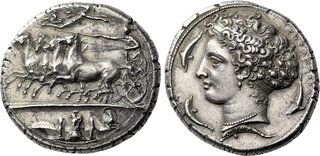| Numismatica Ars Classica > Auction 146 | Auction date: 8 May 2024 |
| Lot number: 2110 Price realized: This lot is for sale in an upcoming auction - Bid on this lot  | Show similar lots on CoinArchives Find similar lots in upcoming auctions on |
| Lot description: Syracuse. Decadrachm signed by Kimon circa 405-400, AR 36 mm, 43.34 g. Fast quadriga driven l. by charioteer, holding reins and kentron; in field above, Nike flying r. to crown him. In exergue, display of military harness set on two steps and below, ΑΘΛΑ. Rev. ΣΥΡΑΚΟΣΙΩN Head of nymph Arethusa l., wearing earring with pendant and beaded necklace; wavy hair bound in front with ampyx and caught up behind by net. Around three dolphins, while a fourth makes dorsal contact with neck truncation, on which the signature ΚΙΜΩN. Rizzo pl. 50, 2 and 52, 2. Jameson 1922 (this coin). Gillet 645 (this coin). de Luynes 1242 (these dies). Regling 2. SNG Fitzwilliam 1271 (these dies). Very rare and in exceptional condition for this important and celebrated issue, possibly the finest specimen known. A portrait of enchanting beauty perfectly struck in high relief on very fresh metal. Virtually as struck and almost Fdc Ex Leu-M&M 28 May 1974, Kunstfreund, 126 and Leu 33, 1983, 239 sales. From the Jameson and Gillet collections. As part of the late phase of the ongoing Peloponnesian War (431-404 BC), in 415 BC the Athenians made the ill-fated decision to strike at the Peloponnesian grain supply and hopefully expand their empire by dispatching a naval expedition to Sicily. The primary target of the expedition was the conquest of Syracuse, the preeminent Dorian Greek city of the grain-producing island. Following an initial battle, the Syracusans endured a protracted siege that involved the construction of extensive wall networks by both besiegers and besieged. At last, after a series of Athenian tactical blunders, in September 413 BC, a Syracusan breakout resulted in the destruction and capture of the Athenian ships and the slaughter of much of the expeditionary force at the Assinarus River. In the aftermath, Syracuse was flooded with silver from the sale of plunder taken from the Athenians and from the sale of captured Athenians and their allies into slavery. It is believed that the outpouring of new Syracusan silver coinage in the last decade of the fifth century BC were struck from this silver that came unexpectedly to Syracuse. At the same time that Syracusan victory and the silver plunder provided the means and opportunity for a new coinage, it also seems to have sparked a great outpouring of artistic genius and a clear pride in the expression of that genius. In this period, commonly known as the age of the signing artists, Syracusan engravers experimented and reached the pinnacle of their art, frequently signing their dies with their names. The present coin is the much sought after and fabulously desirable decadrachm of Syracuse with types engraved by the Syracusan master engraver known only by the name Kimon. His signature KIMΩN is clearly visible on the dolphin swimming below the neck truncation of the exquisite representation of Arethusa. Taking a large flan as his canvas, Kimon here reimagines the standard obverse type of Syracusan silver coinage in classical style. The old slow quadriga of the preceding coinage-inherited from the days of the Deinomenid tyranny-now appears hurtling towards the finish line (presumably at the Olympic games), as the charioteer goads the horses to their limits and Nike appears to crown him with the laurels of victory. A panoply of armour is depicted in the exergue. Although not labelled here, on other obverse dies the armour is accompanied by the Greek legend athla to indicate that it is the victory prize. While such prizes might be appropriate for the winner of a chariot race, one wonders whether there is not a touch of allegory intended in the type, considering the probable source of the silver. The chariot and charioteer may represent Syracuse as the victor in its recent contest with Athens while the prize panoply represents the spoils taken in that contest and used to finance the coinage. Kimon's head of Arethusa on the reverse is universally applauded as a masterpiece of Greek numismatic art. The face is a paradigm of classical perfection framed by incredibly detailed treatment of the hair and the net that holds her hair in place. Estimate: 350000 CHF |  |



